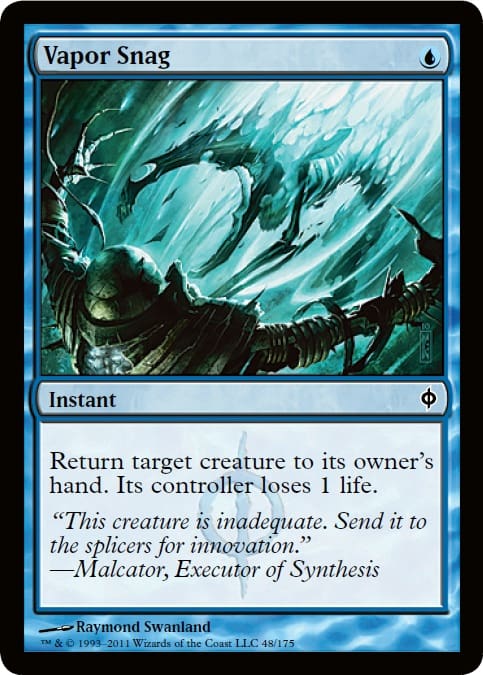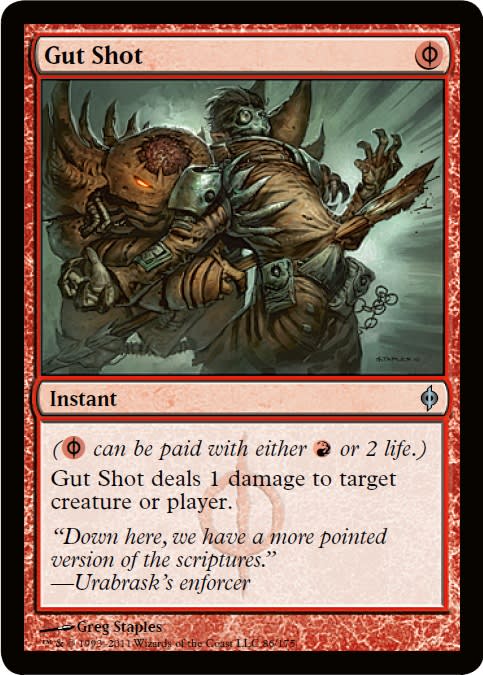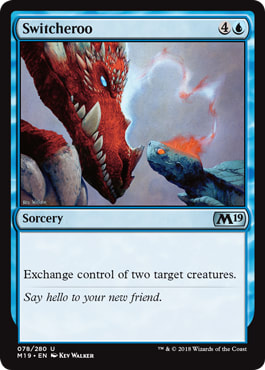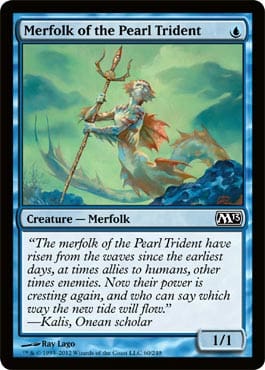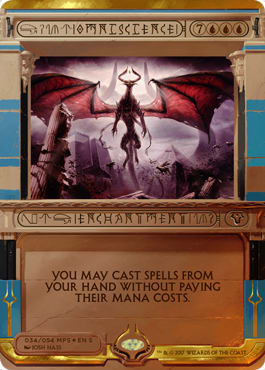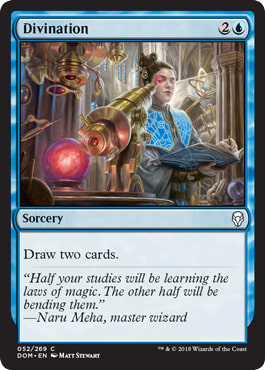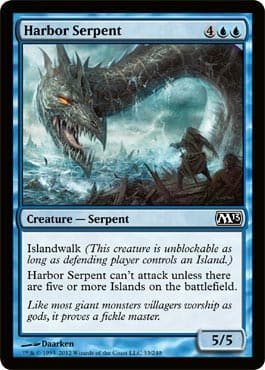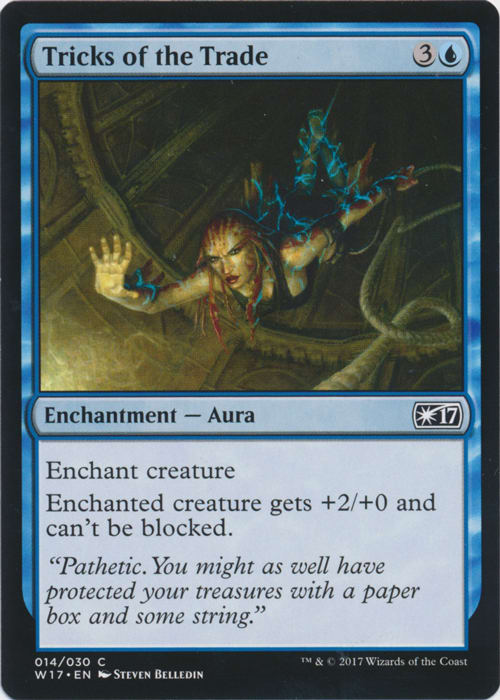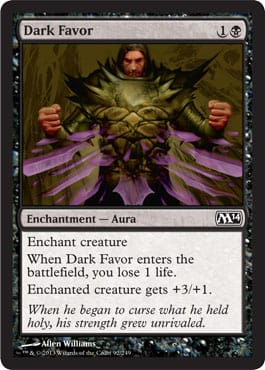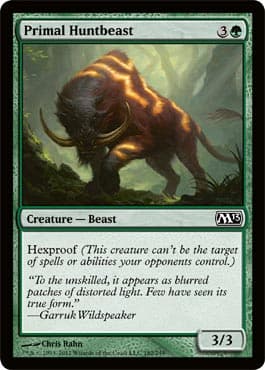This review has hit sort of an odd time block with me moving publication days to Monday, but now we’re back with the most controversial color of all: blue. So let’s dive in.
Feeling Down
Blue has always been Magic’s boogeyman, in most part because its slice of the color pie is very difficult to properly evaluate, and also partly because its mechanical slice has historically been too big. Restricting the ability to manipulate magic to one color in the game of Magic might not have been the ideal decision, but in recent years, Wizards has done a good job of distributing mechanics more evenly. The difficulty of evaluation, on the other hand, is still a problem.
Take Standard, for instance. Do you think development neglected to test Delver of Secrets for Standard? Of course not, but no matter how smart eight guys in a room may be, they can’t match the tuning power of millions of players, and Delver seemed like it would make the deck surrounding it too weak in search of an adequate instant and sorcery count.
The problem of overpowered aggro/control decks isn’t easily solvable because you can only nerf the disruption so much without disabling control decks, and a big portion of the player base loves those. On the other hand, blue should be allowed to have playable creatures below the 6-mana mark, but when these two combine, they form powerhouses such as Delver and Caw-Blade. The only solution I see is to nerf the spells that can enable a tempo game into oblivion and leave only the purely control-oriented ones powerful, but that still leaves counterspells in an awkward place.
As for Magic 2013, none of Divination, Encrust, or Rewind fit very well into anything but a control deck, but Essence Scatter may help perpetuate the current trend even though it is weaker than Mana Leak. Let’s just hope its greater weakness to Cavern of Souls keeps things in check and blue tempo decks can function at a somewhat less oppressive level from here on out.
The Blue Man Group
There are a couple of other interesting things going on here for blue:
At first, this ability may not look like anything new; after all, we saw something similar on Gomazoa back in Zendikar. But Gomazoa was never proactive, and these cards are as different as Shock and Righteous Blow. It’s possible that Void Stalker is just a bleed to help out Commander players, but with the recent introduction of Claustrophobia and Narcolepsy instead of the more standard Dehydration, it seems that R&D has come to the conclusion that every color needs passable creature removal. Given how much more important creatures have become to competitive play in the last few years, I’m inclined to agree.
Mind Control was long regarded as the most powerful uncommon in every Limited environment it graced. Heck, it was stronger than most of the rares, too. So, working on the Goblin Artisans M13 project, we knew we needed a replacement. We considered a bunch of new effects for a marquee uncommon, but we ultimately settled on an ability similar to the one that later ended up on Dungeon Geists. I like WotC’s solution better.
See, we threw out the idea of a nerfed Mind Control pretty early because it would be both despised by the players and less elegant. Or so we thought. While Switcheroo is significantly weaker than Mind Control in a blue deck, it isn’t looked at that way. Nobody is thinking about Switcheroo as a Mind Control that puts you down a card instead of up a card—they’re thinking about giving their opponents 1/1s in exchange for Dragons. The card offers a different dream and thus avoids the problems we expected.
That leaves just the small matter of costing. On one hand, you don’t really want Switcheroo at ![]()
![]()
![]() because people are more likely to compare it unfavorably to Mind Control at that cost. On the other hand, Magic 2011 Limited taught us how much making a color’s top uncommon splashable punishes drafters of that color. With that in mind, it might seem prudent to start Switcheroo at
because people are more likely to compare it unfavorably to Mind Control at that cost. On the other hand, Magic 2011 Limited taught us how much making a color’s top uncommon splashable punishes drafters of that color. With that in mind, it might seem prudent to start Switcheroo at ![]()
![]()
![]() for testing, but the card actually needs to be splashable to weaken blue thanks to the power of Talrand's Invocation. And that, folks, is just one example of the enormous amount of thought put into every detail of every card by the good folks at Wizards; talk about hard work!
for testing, but the card actually needs to be splashable to weaken blue thanks to the power of Talrand's Invocation. And that, folks, is just one example of the enormous amount of thought put into every detail of every card by the good folks at Wizards; talk about hard work!
Having these effects in blue is treading dangerously close to letting the color do too much because of the flavor of mind control. The only reason these cards get a pass in my book is that these two abilities so perfectly capture an Alluring Siren. Why the core set—the place meant to be most resonant—opted for some random Wizard instead is beyond me.
This little Merfolk has nostalgic value, and Development’s even built in some utility for it as a sideboard card against Reckless Brute.dek. Of course, he doesn’t look impressive on his own, so Master of the Pearl Trident is here to help out . . . only he’s not doing that. Merfolk of the Pearl Trident is simply too weak in most Limited matchups to justify playing even if you have the Master. That means that when somebody gets his hands on a copy of the rare and decides to play all of his Merfolk, he’ll have fallen into a trap. It may be that there was no better way to fulfill the nostalgia quota and prepare for the school of Merfolk coming in Return to Ravnica, but avoiding this enormous feel-bad potential would have been high on my list as a developer.
These two Zendikar reprints do a fantastic job of differentiating blue decks into aggressive and controlling archetypes. Don’t get me wrong, a couple of cards like Essence Scatter that are good anywhere are fine, but these cards like Welkin Tern and Kraken Hatchling are what keep a Limited format fresh for months on end, and I wouldn’t be unhappy to see them become core set staples.
To be quite honest, this card makes me a bit uncomfortable. No, not the fact that it circumvents the mana system—costing 10 more or less precludes that in formats newer than Legacy. I’m concerned that this is blue. Omniscience is blue’s goal, but this card doesn’t feel like knowing everything, it feels like unlimited power, or omnipotence. That’s black’s goal. Now, mechanically speaking, this effect isn’t really defined, so I might be okay choosing its color based on flavor, but cheating the multiverse out of its mana shouldn’t fall into blue just because it’s manipulating magic.
There’s plenty more to talk about on a card-by-card basis, but this is running fairly long already, so if there’s more you want to discuss, please bring it up in the comments. In the meantime, let’s talk Draft archetypes:
Replacing the Windows
Azorius
Wait, didn’t I already talk about a tempo-oriented W/U flyers deck in last week’s article? Why yes, strange voice in my head, yes I did. Luckily for the symmetry of this and future articles in this series, the good folks on the Magic 2013 development team have seen fit to craft a deep Limited format with not one, but two decks for each color combination. Now Downpour.dek can make decent use of a couple of Kraken Hatchlings to clog up the ground, but there’s another deck that’s happy with just about as many X/4s as it can get its hands on:
Control’s back, baby! With the presence of real archetypes, Magic 2013 games won’t all devolve into raw card advantage wars as they did in Magic 2010, but W/U is a classic place for this strategy, so I’m glad to see it show up here. Even better, Vedalken Entrancer is great in this archetype because it plays defense and can act as a win condition; that means it’s easy to transition into a full-on gimmicky mill deck with Mind Sculpts!
Izzet
Moving right along, U/R can likewise run a control game. But with Guardians of Akrasa, Pillarfield Ox, and Guardian Lions all being replaced with just Wall of Fire, it requires a different strategy for survival.
It’s common knowledge that in Limited you should hold your removal for a big threat unless you’re forced to use it . . . except in this deck. You need to survive, so blowing your Searing Spear on a Wind Drake isn’t the end of the world when you can just recur it with Archaeomancer or draw into more with any of your numerous card-draw options.
But while blue is good at control, that’s far from its only capability.
Dimir
In Magic 2013 Draft, U/B can run an evasion-plus-ground-clogging game as aggressive W/U decks do, but it needs some way to make up for the decrease in number of evasive threats. Luckily, U/B is much better positioned to use exalted for the tempo game since your one key threat will also get the aid of some sort of awesome Aura.
 |
Pretty much any boost to a Welkin Tern is scary, but Tricks of the Trade in particular can turn even the lowliest Duty-Bound Dead into a wrecking ball of an attacker, at which point one really ought to be enough.
Simic
Our final deck falls outside of the aggro-control split that seems to have divided our options so far. A deck with a ton of green fatties can make excellent use of blue’s early defensive cards to ensure that the monsters have time to come down, and the color’s tempo tricks work just as well, if not better, with big creatures to ensure that the opponent doesn’t have a chance to chump-block and race.
|
How do you even beat this? |
|
Back in Black
I was hoping to get to black today as well, but space-wise, that just doesn’t seem to be plausible, so I guess we’ll leave that until next week. In the meantime, I’d love to know what aspect of Magic design or development you want to see explained or reviewed, so please share your thoughts in the comments.













